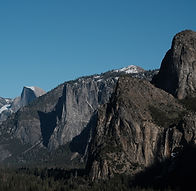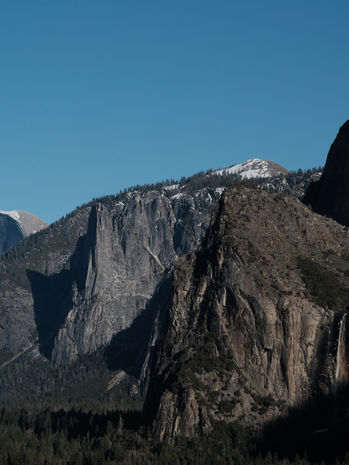Spring & Winter Yosemite
Explore spring waterfalls of Yosemite National Park in a fully equipped expedition vehicle.
Highlights

Tunnel view
Here is a tip: if you are travelling from Yosemite Valley, go through the tunnel, turn around at its end and then return back towards the valley going through the tunnel again. You will be rewarded with an incredible view that opens up as the tunnel ends. If you are after a great photo, try be here about 1hr before sunset, to reduce the shadows. On a clear day, the mist from Bridalveil falls will glow with rainbow colours.

Bridalveil Falls
Bridalveil falls flows year round and it will be one of the most prominent in the valley. There is a short 200m paved trail that leads to the falls, where this photo was taken in February 2020. In the spring time, when the water flow picks up, be ready to cover your camera lens from the mist!

El Capitan
This photo is taken at sunset from the Valley, not far from the El Capitan picnic area where we recommend you have a post-hike snack or a full-on meal. For a fully immersive experience, watch Free Solo a documentary about Alex Honnold's free solo climb to conquer 900m El Capitan.

Mist Trail Hike
While this hike will likely take 4-5hrs, we recommend you plan a full day for this. We certainly welcomed a relaxing afternoon free from activities to let our legs recover from the 11km loop to the top of Vernal Falls. In snowy season, part of this trail remains closed. This photo is taken from a point above the falls close to Clarke Point from our trip in February 2020. If this your first Yosemite visit, this is the can't miss hike.
Park history
Yosemite's first people called themselves Ahwahneechee, after the valley they lived in: Ahwahnee. Their neighbouring tribes called them Yosemites, or "those who kill". Despite the name the tribe was mostly peaceful but when confronted they would fiercely defend their lands.
People resided in the Yosemite region for almost 8,000 years before Spain occupied California. Yosemite's Native Americans spent fall and winter in the valley or the warmer foothills, then roamed the high country in spring and summer in the quest of food. During their hundreds of years of life in Yosemite Valley, the native people were remarkably gentle in their use of land. The staple of the Native American diet in Yosemite and much of the rest of California was acorn, which was prepared and eaten as mush. Mushrooms, as well as clover, bulbs and other plant foods were eaten in abundance. Fish and game included deer, squirrels, trout.
For stories like why the valley was named Yosemite and not Ahwahnee, the discovery of the valley, we recommend Historic Yosemite, a book by Tracy Salcedo.
Weather
Yosemite's climate, surprisingly, is quite mild. However, winters can be snowy and cold though sunny days are common. Winter time in the mountain can bring heavy snow storms. Vehicles entering the park (including 4x4s) are required by law to carry tire chains.
Carry snow chains
they are required during snow storms even for 4x4s.
53F (12C) / 28F (-2C)
Yosemite Valley winter average temperatures
Camping
One option is reserving campsites. Campground reservations become available in one-month blocks up to 5 months in advance. Camping in Yosemite itself is great if you have an activity planned the next morning and want to get an early start to your day. You will also get access to facilities like garbage and toilets.
Another option is camping in National Forest land adjacent to Yosemite - our personal favourite. There are 3 National Forests close by: Inyo National Forest, Sierra National Forest and Stanislaus National Forest. The coolest part? No reservations needed! Make sure your map confirms you are within the range of the national forest and camp wherever. You can even make campfire - just be sure to obtain the campfire permit here http://permit.preventwildfiresca.org. As always, be sure to leave the camp spot better than you found it and use a shovel when nature calls!
When you book a fully-equipped adventure vehicle with us, we provide a route with GPS coordinates to make finding camp spots seamless. We spend all of our free time looking for new spots with jaw-dropping views so you don't have to.
Need a shower? In Yosemite Valley, there are showers at Curry Village (open all year) and at Housekeeping camping (closed in winter). There is a fee for all showers.






